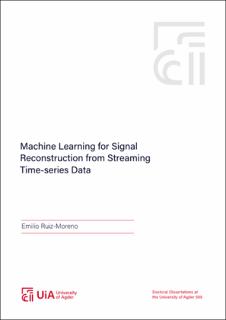| dc.contributor.author | Moreno, Emilio Ruiz | |
| dc.date.accessioned | 2024-01-30T13:13:21Z | |
| dc.date.available | 2024-01-30T13:13:21Z | |
| dc.date.created | 2024-01-26T14:17:57Z | |
| dc.date.issued | 2024 | |
| dc.identifier.citation | Moreno, E. R. (2024). Machine Learning for Signal Reconstruction from Streaming Time-series Data. [Doctoral dissertation]. University of Agder. | en_US |
| dc.identifier.isbn | 978-82-8427-173-6 | |
| dc.identifier.issn | 1504-9272 | |
| dc.identifier.uri | https://hdl.handle.net/11250/3114510 | |
| dc.description | Papers I and II are extracted as separate files to meet IEEE publication policy for accepted manuscripts. | en_US |
| dc.description.abstract | Nowadays, deploying cyber-physical networked systems generates tremendous streams of data, with data rates increasing as time goes by. This trend is especially noticeable in several fairly automated sectors, such as energy or telecommunications. Compared to the last decades, this represents not only an additional large volume of data to explore and the need for more efficient and scalable data analysis methods but also raises additional challenges in the design and analysis of real-time streaming data processing algorithms. In many applications of interest, it is required to process a sequence of samples from multiple, possibly correlated, data time series that are acquired at different sampling rates and which may be quantized in amplitude at different resolutions. A commonly sought goal is to obtain a low-error signal reconstruction that can be uniformly resampled with a temporal resolution as fine as desired, hence facilitating subsequent data analyses. This Ph.D. thesis consists of a compendium of four papers that incrementally investigate the task of sequentially reconstructing a signal from a stream of multivariate time series of quantization intervals under several requirements encountered in practice and detailed next. First, we investigate how to track signals from streams of quantization intervals while enforcing low model complexity in the function estimation. Specifically, we explore the use of reproducing kernel Hilbert space-based online regression techniques expressly tailored for such a task. More specifically, the core techniques we devise and employ are influenced by the abundant theoretical and practical benefits in the literature about proximal operators and multiple kernel approaches. Second, we require the signal to be sequentially reconstructed, subject to smoothness constraints, and as soon as a data sample is available (zero-delay response). These well-motivated requirements appear in many practical problems, including online trajectory planning, real-time control systems, and high-speed digital-to-analog conversion. We address this challenge through a novel spline-based approach underpinned by a sequential decision-making framework and assisted with deep learning techniques. Specifically, we use recurrent neural networks to capture the temporal dependencies among data, helping to reduce the roughness of the reconstruction on average. Finally, we analyze the requirement of consistency, which amounts to exploiting all available information about the signal source and acquisition system to optimize some figure of reconstruction merit. In our context, consistency means guaranteeing that the reconstruction lies within the acquired quantization intervals. Consistency has been proven to entail a profitable-in-practice asymptotic error-rate decay as the sampling rate increases. Particularly, we investigate the impact of consistency on zero-delay reconstruction and also incorporate the idea of exploiting the spatiotemporal dependencies among multivariate signals. | en_US |
| dc.language.iso | eng | en_US |
| dc.publisher | University of Agder | en_US |
| dc.relation.ispartof | Doctoral dissertations at University of Agder | |
| dc.relation.ispartofseries | Doctoral dissertations at University of Agder; 456 | |
| dc.relation.haspart | Paper I: Ruiz-Moreno, E. & Beferull-Lozano, B. (2021). Tracking of quantized signals based on online kernel regression. 2021 IEEE 31st International Workshop on Machine Learning for Signal Processing (MLSP), IEEE, 1-6. https://doi.org/10.1109/MLSP52302.2021.9596115. Accepted version. Full-text is not available in AURA as a separate file. | en_US |
| dc.relation.haspart | Paper II: Ruiz-Moreno, E. & Beferull-Lozano, B. (2023). An online multiple kernel parallelizable learning scheme. IEEE Signal Processing Letters, 31, 121-125. https://doi.org/10.1109/LSP.2023.3343185. Accepted version. Full-text is not available in AURA as a separate file. | en_US |
| dc.relation.haspart | Paper III: Ruiz-Moreno, E. , López-Ramos, L. M. & Beferull-Lozano, B. (2023) A trainable approach to zero-delay smoothing spline interpolation, IEEE Transactions on Signal Processing, 71, 4317-4329. https://doi.org/10.1109/TSP.2023.3329946. Accepted version. Full-text is available in AURA as a separate file: https://hdl.handle.net/11250/3107150 | en_US |
| dc.relation.haspart | Paper IV: Ruiz-Moreno, E., López-Ramos, L. M. & Beferull-Lozano, B. (Consistent signal reconstruction from streaming multivariate time series. IEEE Transactions on Signal Processing. Submitted version. Full-text is not available in AURA as a separate file. | en_US |
| dc.rights | Attribution-NonCommercial-NoDerivatives 4.0 Internasjonal | * |
| dc.rights.uri | http://creativecommons.org/licenses/by-nc-nd/4.0/deed.no | * |
| dc.title | Machine Learning for Signal Reconstruction from Streaming Time-series Data | en_US |
| dc.type | Doctoral thesis | en_US |
| dc.description.version | publishedVersion | en_US |
| dc.rights.holder | © 2024 Emilio Ruiz-Moreno | en_US |
| dc.subject.nsi | VDP::Teknologi: 500::Informasjons- og kommunikasjonsteknologi: 550 | en_US |
| dc.source.pagenumber | 139 | en_US |
| dc.source.issue | 456 | en_US |
| dc.identifier.cristin | 2235388 | |




